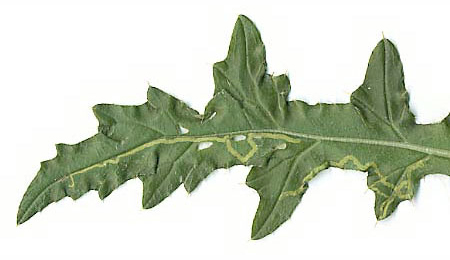|
||||||
|
Phytomyza
spinaciae Hendel, 1928 Phytomyza
spinaciae Hendel, 1928. Blattminenkunde Europas. I. Die
Dipterenminen. Wien: 68 |
|||||||||||||||||||||||||||||||||||||||||||||||||||||||||||||||||||||
Leaf-miner: Long narrow interparenchymal mine, greenish. Pupation in leaf at end of mine (Spencer, 1976: 503 (fig. 880)). Unusually long, interparenchymatous, therefore yellowish corridor that remains of equal width throughout its length. (In some plants with thin leaves, like Cirsium oleraceum the mines are not interparechymatous but either full-depth or alternating upper- and lower-surface). The mine makes few curves, and hardly any u-turn, causing the mine to usually occupy the entire length of a leaf. Frass in two rows of grains along the sides. Pupation within the mine, in a lower-surface puparial chamber; the anterior spiracles penetrate the epidermis (Bladmineerders van Europa).
Larva: The larvae of flies are leg-less maggots without a head capsule (see examples). They never have thoracic or abdominal legs. They do not have chewing mouthparts, although they do have a characteristic cephalo-pharyngeal skeleton (see examples), usually visible internally through the body wall. The larva is described by de Meijere (1928) and illustrated in (Bladmineerders van Europa). Puparium: The puparia of flies are formed within the hardened last larval skin or puparium and as a result sheaths enclosing head appendages, wings and legs are not visible externally (see examples). White; posterior spiracles each with 18-20 minute bulbs on small conical protuberance (Spencer, 1976: 503). The puparium is illustrated in Bladmineerders van Europa. Comments: All British records require confirmation. Hosts in Great Britain and Ireland:
Hosts elsewhere: Time of year - mines: July, October. Time of year - adults: Currently unknown. Distribution in Great Britain and Ireland: Warwickshire (Coventry) (Robbins, 1991: 121); Cambridgeshire, East Gloucestershire, East Suffolk, Pembrokeshire, South-west Yorkshire and Stafford (NBN Atlas). Also recorded on Meadow Thistle (Cirsium dissectum), 13.6.1985 at Lough Corrib, Co. Galway, Ireland (H.C.J. Godfray). Distribution elsewhere: Widespread in continental Europe including Belgium (Scheirs et al., 1994; Scheirs, de Bruyn and von Tschirnhaus, 1996), Denmark, Finland, Norway, Sweden (Spencer, 1976: 503), The Netherlands (Bladmineerders van Europa), Germany (Spencer, 1976: 578), Czech Slovakia, French mainland, Latvia, Lithuania and Spanish mainland (Fauna Europaea). Range extending to the Kirghiz Republic of the [former] U.S.S.R. (Spencer, 1976: 503). NBN Atlas links to known host species: British and Irish Parasitoids in Britain and elsewhere:
|
|
|
|
| External links: | Search the internet: |
| Biodiversity Heritage Library Bladmineerders van Europa British leafminers Encyclopedia of Life Fauna Europaea NBN Atlas NHM UK Checklist |
Find
using Google Find using Google Scholar Find images using Google |
| Last updated 09-Nov-2017 Brian Pitkin | ||

